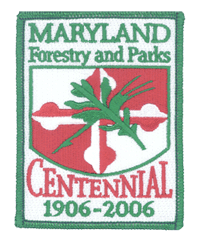 Hunters’ Valuable Contributions to Forest Conservation, Wildlife Restoration and Public Land
Acquisition
Hunters’ Valuable Contributions to Forest Conservation, Wildlife Restoration and Public Land
Acquisition
By Francis Zumbrun
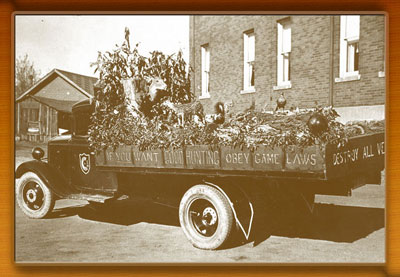
Aldo Leopold, Teddy Roosevelt and Gifford Pinchot are
names that most people
recognize as great leaders of the North American
conservation movement; however,
most people probably don’t realize they were also
hunters. It has been said that
hunters were the first conservationists. Hunters,
fishermen and outdoor
enthusiasts have a close, personal attachment to the
forests, fields and streams
that support wildlife and fish habitat.
Early in the 20th century hunters including Leopold,
Roosevelt and Pinchot
recognized that certain activities such as unregulated
hunting, large-scale land
clearing, wildfires, and soil erosion were having
dramatic impacts not only on
our wildlife, but on their habitats and on forest
health as well. Along with a
growing movement of like-minded individuals, they saw
the need for stricter laws
and regulations, for government to manage and protect
both wildlife and lands,
and for sustainable funding to carry out this mission.
The abundant natural
resources that we enjoy today and the public lands
that help ensure access to
them are a testament to their efforts.
In 1936, the O’Neal family began camping and hunting
at Green Ridge State
Forest (see story below); one year later, one of the
most important pieces of federal legislation
was passed. Known as the Pittman-Robertson or Federal
Aid in Wildlife
Restoration Act, it directs that 11 percent of the
purchase price for firearms,
ammunition and archery equipment go to the federal
government and then to state
natural resource agencies for wildlife conservation.
As a result, hunters have
contributed over two billion dollars annually to
national forest and wildlife
conservation efforts since 1937.
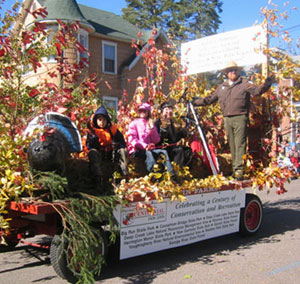
A Century of Conservation and Recreation: Fall Color Festival, Oakland, Md. - 2006 |
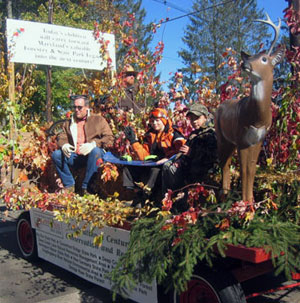 |
Sportsmen have also contributed an estimated $185
million per year to forest and
wildlife conservation through the purchase of hunting
and trapping licenses or
tags. Over the last century, it is estimated that
hunters such as the O’Neal
family have contributed over $5.5 billion toward
forest and wildlife
conservation.
Hunters continue to make significant contributions to
Maryland’s economy.
According to a 2001 national wildlife survey, the
estimated annual economic
impact of deer, squirrel, turkey and grouse hunting
statewide was about $301
million. In honor of Maryland Forestry and Parks
centennial year, we pay tribute
to hunters like the O’Neal family for their
considerable contributions to forest
and wildlife conservation in Maryland.
The O’Neal Family: Seventy Years of Camping and
Hunting at Green Ridge State Forest (1936-2006)
By Francis Zumbrun
 |
 |
|
Clarence Alonzo O'Neal (circa 1936) camping and hunting at Green Ridge State Forest. The O'Neils began camping at Green Ridge five years after the State Forest was founded, and seventy years later, the family tradition continues.
|
For seventy years, five generations of O’Neal and
Murphy families have camped
and hunted at Green Ridge State Forest. I recently
stopped by the family’s
campsite on Howard Road to visit with them. On this
particular day, brothers Bob
and Jim O'Neal and their cousin Ron O'Neal, were
present.
“Your family’s been camping and hunting in Green Ridge since 1936. What keeps bringing them back?” I asked.
Bob answered simply, “We are returning to the place of our youth. Every hollow and ridge holds a memory for us.” Then he continued: “Our grandfather, Clarence
Alonzo O'Neal, started it all. He was from Mount
Savage. Rabbit hunting brought him to Green Ridge State Forest.”
I mentioned that in 1936 remnants of the famed
Mertens’ apple orchard still
existed. The orchard once provided great rabbit
habitat. Today hunters still
kick up corrugated wire tree protectors from under the
leaves on the forest
floor where apple trees once grew.
/centennial/Bacil-O'Neal.jpg
alt="O'Neil's
hunting cabin at Green Ridge State Forest, a converted
mule shed. Over the years, the O’Neals have
camped and hunted primarily at three different
locations within the 15 Mile Creek watershed at Green
Ridge. They started with
tent camping off of M.V. Smith Road near Catpoint
Road; then in the 1940s, they
converted a mule shed into a hunting cabin on the
Shircliff property, a private
tract in the forest. When their lease expired around
1969, the O'Neals returned
to tent camping, mainly on Dug Hill Road and Howard
Road.
“As kids we knew we were about to take ‘the
mountain trip’ to Green Ridge when
our grandfather announced it was time to go to camp,”
Jim said.
The O’Neals explained to me that when school let out
they spent the first two
weeks of their summer vacation at Green Ridge. “We
were dropped off at our
campsite and Grandfather O'Neal looked after us,” Jim
said. “Sometimes you’d
find us wading in the 15 Mile Creek swimming hole;
other times you’d find us
fishing.”
Grandfather O’Neal instilled respect for gun safety in
his grandchildren. “We
were told to break down a gun as soon as we walked out
of the woods and unload
immediately,” Ron explained. “Grandfather would tell
us: Don't point a gun at
anything you don't expect to kill, don't shoot
anything you don't expect to eat,
and know what you're shooting at and what's behind
it."
Jim continued, “We started hunting with supervision as
young teenagers - it was
a rite of passage. We did shoot a few groundhogs at
the age of nine, but we had
to eat them.”
The O’Neals have never hunted deer, choosing to stick
with squirrel, grouse and
turkey. I asked them how conditions have changed at
Green Ridge over the years.
According to Ron, grouse were more plentiful in the
1950s and ‘60s. In the ‘50s,
grouse habitat was better in much of the forest
because it was in an earlier
stage of development, providing ideal ruffed grouse
habitat.
“Green Ridge State Forest was packed with hunters back
then. You coughed to let
others know you were around,” Bob remembered. “We are
proud that since 1936, no
one in our family has received a citation for a
hunting violation.”
I asked the O’Neals if they ever observed a rare
squirrel migration at Green
Ridge. My research showed that the last great squirrel
migration occurred in
1968 in the eastern United States.
Bob recalled that as teenager he observed what might
have been such a migration.
He remembered seeing large numbers of squirrels
passing at one time through the
forest, and the older men saying that the animals were
following the feed and
moving on to another area.
I shared with them a naturalist’s account recorded in
1811 of a vast migration
observed in the Ohio Valley: "A countless
multitude of squirrels, obeying some
great and universal impulse which none can know but
the Spirit that gave them
being, left their reckless and gamboling life, and the
ancient places of retreat
in the north, were seen pressing forward by tens of
thousands… to the South..."
We paused to contemplate the wonder of it all. Later
as I made to leave, the
O’Neals thanked me for visiting their campsite and
taking an interest in them.
But I thought I should be thanking them. For it is
through the significant
contributions of dedicated outdoorsmen like the
O’Neals that Maryland’s forest
health, public land acquisition, and restoration of
wildlife habitat efforts
have been possible.
 Point Lookout in Green Ridge State Forest really
is one of “Maryland’s best-kept secrets.” Not to be confused with the
southern Maryland state
park of the same name, visitors to Point Lookout
have a spectacular view
of the ancient Potomac River valley. DNR
established the area around Point
Lookout as wildlands, thus protecting the view
on the Maryland side.
Visitors to Point Lookout today can enjoy the
same view that the Union
troops had 140 years ago when they used Point
lookout to observe
Confederate movements through the valley. Also
from this historic
overlook, one can survey 243 acres of land once
owned by George
Washington, first President of the United
States. Point Lookout in Green Ridge State Forest really
is one of “Maryland’s best-kept secrets.” Not to be confused with the
southern Maryland state
park of the same name, visitors to Point Lookout
have a spectacular view
of the ancient Potomac River valley. DNR
established the area around Point
Lookout as wildlands, thus protecting the view
on the Maryland side.
Visitors to Point Lookout today can enjoy the
same view that the Union
troops had 140 years ago when they used Point
lookout to observe
Confederate movements through the valley. Also
from this historic
overlook, one can survey 243 acres of land once
owned by George
Washington, first President of the United
States. |
|
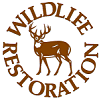
|
U.S. Fish & Wildlife
Service |
|
Federal Aid in (Pittman-Robertson)
|
|
THE FEDERAL AID IN WILDLIFE RESTORATION ACT |
Where Does the
Money Come From
The Federal Aid in Wildlife Restoration Act,
popularly know as the
Pittman-Robertson Act, was approved by Congress
on September 2, 1937, and
begin functioning July 1, 1938.
The purpose of this Act was to provide
funding for the selection,
restoration, rehabilitation and improvement of
wildlife habitat, wildlife
management research, and the distribution of
information produced by the
projects.
The Act was amended October 23, 1970, to include
funding for hunter
training programs and the development, operation
and maintenance of public
target ranges.
Funds are derived from an 11 percent Federal
excise tax on sporting
arms, ammunition, and archery equipment, and a
10 percent tax on handguns.
These funds are collected from the manufacturers
by the Department of the
Treasury and are apportioned each year to the
States and Territorial areas
(except Puerto Rico) by the Department of the
Interior on the basis of
formulas set forth in the Act. Funds for hunter
education and target
ranges are derived from one-half of the tax on
handguns and archery
equipment.
Each state's apportionment is determined by a
formula which considers
the total area of the state and the number of
licensed hunters in the
state. The program is a cost-reimbursement
program, where the state covers
the full amount of an approved project then
applies for reimbursement
through Federal Aid for up to 75 percent of the
project expenses. The
state must provide at least 25 percent of the
project costs from a
non-federal source.
- Reprinted from the
http://federalasst.fws.gov/wr/fawr.html
|
Acknowledgements:
Francis "Champ"
Zumbrun....is the forest manager at Green Ridge State Forest. He has worked as a professional
forester for DNR since 1978. He is currently
researching the life of Thomas Cresap (1694-1787),
Maryland's great pathfinder, pioneer and patriot. In
1733, Cresap cleared the Old Conestoga Road between York, PA and Union Bridge, MD. Francis is interested in hearing from anyone who has information about this
colonial road and its original alignment.
Note: Green Ridge is the second
largest of Maryland's
State Forests consisting of a 44,000-acre oak-hickory
forest. It is located in
eastern Allegany County, approximately eight miles
east of Flintstone off I-68
at Exit 64.
Read More About ...